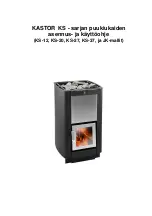
56
4
After another 10 minutes close the charging door completel�. Check the fire. Now
close the primar� air inlet valve to minimal whilst still ensuring good burning fire
(see chapter d.1.1.).
D.1 hOW TO REcOgnizE A cORREcT AnD incORREcT BURning sTOVE
D.1.1 correct burning stove
how can a correct burning stove be recognized:
•
the flames are moving calm
•
the wood is burnt evenl�
•
after the stove is in operation for more than approximatel� 30 minutes the
smoke should nearl� be translucent.
D.1.2 incorrect burning stove
how can an incorrect burning stove be recognized:
•
smother� flames
•
extensive smoke production
•
soot covering the window pane
D.2 REFiLLing ThE sTOVE
how can an incorrect burning stove be recognized:
•
shake the ash grid using the de�ashing mechanim (see picture 3).
•
open the charging door using a heat protection glove (not delivered with
the stove)
•
place new dr� fire wood. Max 2 pieces per refilling c�cle. Onl� fill the stove
with a single la�er of wood.
•
close the charging door
•
keep the charging door open for shortest possible time.
Avoid operating the stove at windless weather and fogg�/mist� weather. At these
weather conditions it is possible there will not be enough draught to properl�,
safel� and efficientl� operate the stove. It might result in exhaust gasses entering
the room and/or lead to other inconveniences, ma�be even outside �our premises.
overheating the stove can cause damage to stove and its surroundings. overhea-
ting the stove is normall� caused b� too much wood load and/or too much primar�
air inlet. never overheat the stove.
G
DURing nORMAL OPERATiOn:
• The primar� air inlet valve must be kept to a minimum –whilst still ensu
-
ring a good burning fire-, this will ensure that the burning process is as
clean as possible and the efficienc� is as high as possible.
• The capacit� and efficienc� of the stove varies with the kind of wood as
well as with the wood load.
• The capacit� of the stove can best be controlled b� var�ing the wood load
Make sure to ventilate the room sufficientl�.
Picture 3:
De-ashing mechanism
















































